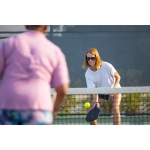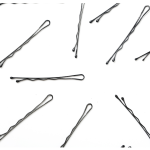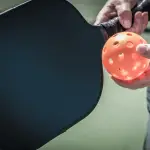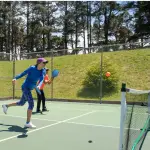Like many people, professional player Kyle McKenzie competed in tennis before Pickleball. But what’s unusual about his story is that he also played poker for a living in his early 20’s. Kyle said he had always been a tactician at heart so poker was a great fit for his interests and he applies many of the ideas from poker to Pickleball.
Know When to Fold
One poker style that he thinks of as being similar to Pickleball is the idea of frequently folding your hand. This is a very patient style of poker where you often choose not to play the hand because it isn’t strong enough to win in most situations. The patience needed to fold in poker is similar to the patience it takes to play long dink rallies during a doubles Pickleball game. You mainly see this style at higher levels of play because these players know the fewer mistakes you make, the more likely you are to win the game.
Kyle said, “When people found out that I played poker they’d always say oh, you like to gamble and yeah not really. I just really like to win. And so I think patience was really a reflection of that. I didn’t know if I was the smartest poker player because as you get to the higher levels of professional play there’s a lot of former MIT students and people who really understand math and algorithms and have a really just high level of intelligence. And so to me, I felt like patience was an equalizer. It was the best way to avoid making mistakes.”
Dinking and Poker
In delving deeper into the idea of patience in Pickleball, Kyle discussed two types of dinks. While many will just think of the forehand and backhand dink, he breaks up dinking into two categories: the lift dink and the push dink. The lift dink is more defensive in nature and refers to having more margin for error. So, you are hitting the ball higher over with net with the goal of making the ball land in the kitchen. Kyle said, “Often times what you’re inherently giving up with the lift dink is you’re putting more ball shape and more air under the ball. You are vulnerable to a good attacking player potentially initiating an attack off the bounce.”
A push dink is one where your opponent hits you a lift dink and you can be more offensive with it. Kyle said, “the push stink is a shot that’s used where you’re acknowledging yourself for taking a little bit more risk. But the goal of the shot is to put your opponent under a little bit more pressure by playing a more linear ball near their feet, maybe making it a little bit more awkward for them. Maybe there’s some indecision about whether they should take the ball out of the air or take the ball off the bounce.” When talking about playing a more linear ball, the idea is to hit more of a line drive which goes closer to the net.
Kyle said the goal he has when teaching the dink shot it for his students to understand what is happening during the long dink rallies that professionals have. He said, “You’re watching these long dinking exchanges especially at the pro level, you’re not just looking at this dink exchange is going on for a long time. But you’re able to see which team is in control with the push stink and which team is lifting and trying to get back to neutral with that lifting.” At higher levels of play, the team with control can switch two or three times during one point. But it’s okay to not be in control. You just need to be patientt, like in poker, and get back to neutral before taking control again.






